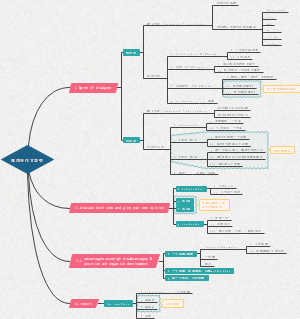导图社区 英语基础知识思维导图
- 375
- 27
- 2
- 举报
英语基础知识思维导图
英语基础知识包含十大词性、八大成分、五大句型,全部整理至下图,超详细!
编辑于2020-10-09 21:19:34- 专业英语
- 相似推荐
- 大纲
基础知识
a. 十大词性
a.1. 名词n.
分类
专有名词 例:the Great wall
普通名词
个体名词 例:book
集体名词 例:group,family,class
物质名词 例:glass, glass
抽象名词 例:progress,ambition
名词的数
可数名词
有单复数之分 a/an/this+n.或n.+s
可数n.单(复)数与谓语v.单(复)数连用
不可数名词
与谓语v.单数连用
常见的不可数名词
水,信息,知识,运气,钱,进步,建议,新闻,工作等
名词所有格
's所有格(表有生命的n.的所有关系) A's B意为A的B
of所有格 (表无生命n.的所有关系) A of B意为B的A
双重所有格
of+'s所有格 例:a friend of my mother's
a/an/the/that/+n.+of+名词性物主代词 例:a friend of mine
概念
a.2. 代词(pron.)
概念
分类
人称代词
主格(做主语,放v.前)
宾格(做宾语,放v.或介词后)
物主代词
形容词性物主代词+n.=名词性物主代词 例:your bag=yours
形容词性物主代词
名词性物主代词
指示代词
常考:在比较级或同级结构中,that可代替不可数n.,those可代替复数n.
指示代词:this,that,these,those
相互代词
one another ; each other互相
疑问代词
who what whose whom which
关系代词
who whom whose which that
不定代词
常考不定代词辨析:
1,all none both either neither辨析
重点掌握either和neither! 常考:Either(两者中的任意一个)/Neither(两者都不)+of+the+n.复数+v.单数 例:Either of the girls is diligent. Neither of the girls is lazy.
2,every与each
3,other ,others ,the other,another ,another one ,one another辨析
重点考有关another!! another表“另一个再一个” another+可数n.单:another one另外一个 another+数词+n.复 表“另外几个...” one another=each other彼此互相
4.any, any other,every,every other辨析
every 每一个 every day 每天 every other 每隔 every other day每隔一天 特别注意any other用法 any+单数n.表“任何一个”(表示包含所有人) any other+单数n.表“其他任何一个人”(表示把某人排除在外) 例:She is more diligent than any other student in our class.
many much few . a few little a little…
反身代词
常考搭配
teach/enjoy oneself自学/玩得开心 help oneself to...随便吃... by oneself独自 for oneself为自己 in itself本身 of oneself自发地
a.3. (限定词)
冠词:a/an/the art.
冠词用法
the表特指 a用于辅音发音开头的单词前 an用于元音发音开头的单词前 易错单词:a university/useful/European… an hour/honest/honor/umbrella/example
位置
考点:1.what/such/many/half+a/an+(adj.)+n. 2.{how/so/as/too/however/enough}+(adj.)+a/an+n. { }做adv.修饰后面adj.
限定词与名词搭配关系
只能跟可数名词单数
each. every. either. neither. many a. another等
只能跟可数名词复数
many. few. a few. a number of. several等 (有几个) (许多)
只能跟不可数名词
much. little. a little. a large amount of. a great deal of. a bit of等
能跟可数名词复数也可跟不可数名词
a lot of. lots of. plenty of. enough等
基础掌握!!
限定词与限定词的搭配关系
前位限定词
all,both ,half ;倍数(double.twice等);分数(one-third等);what,such等
中位限定词
冠词,指示代词,物主代词,名词所有格,不定代词等
后位限定词
基数词,序数词,next.last.other.another等
限定词使用规则:排序:前位+中位+后位(同一个n.词组中,通常不可以用两个前位或两个中位,而后位可以叠用)
例:他的两个女儿 all his two daughters
概念
a.4. 动词v
概念
分类
系动词
!!重点背背!!
be v.:am/is/are/was/were “是”
感官v.:look/sound/smell/feel/taste “...起来”
表象/保持/变得/终止:seem/appear似乎 keep/remain/stay保持 become/turn yellow/go bad/get“变得” turn out/prove“结果是”
实义动词
概念
分类
及物动词(vt.)
不及物动词(vi.)
情态动词
“应该”:can,may,could,might,shall,should,will,would,must,need,ought to
情态动词+v.原
助动词
do,does,did,has,have,had,am,is,are,was,were
基本形式
动词原形
动词单数
过去式
过去分词
现在分词
谓语形式
a.5. 连词conj.
a.6. 介词prep
a.7. 形容词adj.
a.8. 数词num.
a.9. 副词adv
a.10. 感叹词int.
b. 八大成分
b. 八大成分:主,谓,宾,定,状,补,表,同位 基本成分:主,谓,宾,宾补,表 修饰成分:定,状,同位,插入语
b.1. 主语
通常由名词,代词,不定式,动名词,相当于名词的词组或从句,引用充当
注意:v.原形和adj.不能作主语!!!!
概念
例:Watching TV is bad for our eyes.
b.2. 谓语(动词充当)
谓语形式
单个动词 do,did,done
动词短语
助动词+动词 (时态语态)
情态动词+动词原形
概念
实义动词分类
不及物动词(vi.)
常见的不及物动词
常见的不及物动词: come,go,work,die,lie,fail,live,succeed,rise(升起,增加),arise(发生,出现),listen,look,agree,arrive,sit,happen,take place,occur,belong to,break out(爆发),exist(存在),hurry(to),fly ,stay,communicate,talk,differ,fight(for),graduate,swim等
不接宾语,若跟宾语需加介词
例:This thing happened to me.
单宾动词
例:I drink water every day.
双宾动词
常见的双宾动词
(一)...sb sth=...sth 《to》sb 🈶 give,bring,hand,lend,mail,offer,pass,return,send,sell,show,teach,tell,write等 (二)...sb sth=...sth《for》sb 🈶 buy,book,cook,fetch取,save留
宾补动词
分为感官动词和使役动词
常见的宾补动词
常用名词或形容词做宾补:find,make,think,consider,prove,keep
例:I find English very interesting.
常用to do做宾补:want等后接to do sth的
想要,鼓励,惩罚,告诉,允许,建议,帮助,邀请,禁止,期待,命令order,permit允许,希望wish/hope
b.3. 宾语
分为动词宾语和介词宾语
通常由名词,代词,to do,doing,句子充当
概念
例:He decides to adopt a child.
b.4. 表语
通常由名词,形容词,to do,分词,介词短语,代词,数词,句子等充当
例:My hobby is collecting stamps. My purpose is to see him.
注意:加be动词
例:We are in the classroom.
概念
b.5. 宾补
通常由名词,形容词,to do,分词,介词短语,副词等充当
例:We call the bird Polly.
b.6. 定语
单词做定语放修饰名词前,短语或句子作定语时放修饰名词后
例:This is my bag. The doctor in the room is Amy.
通常由形容词,代词,分词,to do,介词短语,句子,数词等充当
概念
b.7. 状语
分类:时间,地点,原因,目的,条件,结果,方式,让步,程度和伴随状语
例:He studies hard to pass the exam.
通常由副词,介词短语,to do,doing,done,句子充当
位置:adv.修饰v.时,任意位置,常放句末 频度副词放实义动词前、be动词/助动词后;程度副词修饰adj./adv.时,放所修饰的动词前
例:She is very cute. We often go to school by bus.
概念
b.8. 插入语
位置随意,可添加逗号
例:English,I think,is important. English I think is important.
b.9. 同位语
放在名词之后,通常由名词,代词,句子充当
例:I,your best friend,will try my best to help you.
c. 五大基本句型
拓:There be 句型 句型中be不能换成have!!!,be动词单复数取决于其后的名词(真正的主语)
There be 句型:be存在,have拥有 there be+n.+时间/地点,表示“某地/某地有某物”
c.1. 主+谓(不及物v.)
例:The phone rang.
c.2. 主+谓(及物v.)+宾(单宾单词)
例:You received a message two minutes ago.
c.3. 主+谓+宾+宾(双宾单词)
例:He gave you a surprise.
c.4. 主+谓+宾+宾补(宾补单词)
例:This made you happy.
c.5. 主+系+表
d. Grammar Focus









